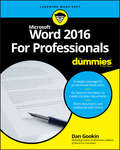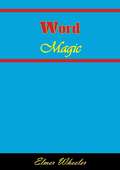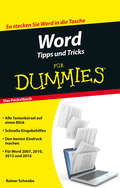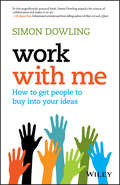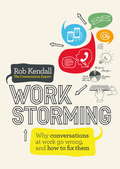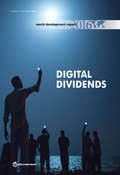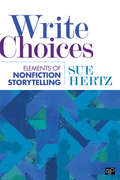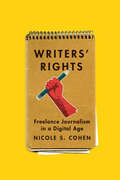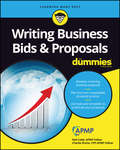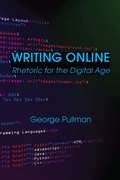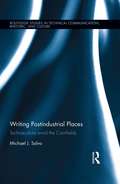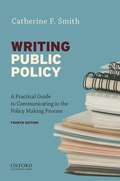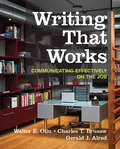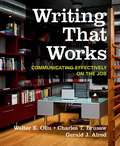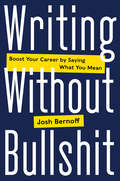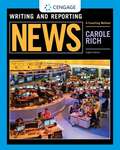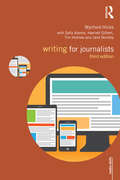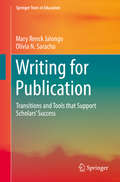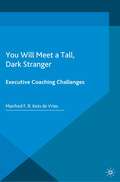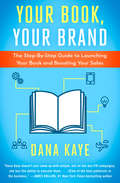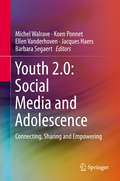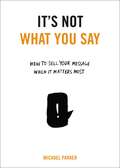- Table View
- List View
Word 2016 For Professionals For Dummies
by Dan GookinWhat the book covers: In this leading book about the world's number-one word processing software, Dan Gookin talks about using Microsoft Word in friendly, human--and often irreverent--terms. Based on his own experience, he focuses on the needs of the Word Power User by offering deep coverage of the topics professionals want more information about so they can be more productive and efficient.
Word Magic: Tested Answers to 100 Everyday Situations
by Elmer WheelerAbout ten years ago, a newspaper man developed an idea for increasing sales through a more effective use of words. Now, Elmer Wheeler, its originator, has put into this new book the fundamental principles responsible for his success and has adapted them to help you meet those many personal situations confronting you at home, in the office, and in society.No matter who you are, no matter what your position in life is, you depend upon words for your success and happiness. The right words can win you a job, a wife, or a promotion. The wrong words can lose friends for you in social life, block your progress in business, or make you miss your big chance.Adopting a keen, homely, back-to-the-woods philosophy, Mr. Wheeler has taken an ordinarily serious subject and dramatized it so that anyone can put it to immediate and practical use.
Word Tipps und Tricks für Dummies (Für Dummies)
by Rainer W. SchwabeAuf ein gutes Word! Sie möchten endlich in Word Ihre Arbeitsabläufe effektiver gestalten? Dann ist das Taschenbuch mit dem Aha-Effekt genau das Richtige für Sie! Rainer Schwabe zeigt kurz und bündig, wie Sie Word nach Ihren Anforderungen und Wünschen gestalten und mit welchen geheimen Tricks alles noch viel schneller geht. Heben Sie sich aus der Word-Masse zum Beispiel mit richtigen Serienbriefen, schönem Layout und übersichtlichen Tabellen hervor. Machen Sie schnelle Eingaben, erstellen Sie eigene Tastenkürzel und Befehle. Schöpfen Sie aus dem Word-Vollem!
Work with Me: How to get people to buy into your ideas
by Simon DowlingLead from any level with the power of buy-in Work with Me shows you how to master the art of the 'buy-in.' You achieve better results when people go along with your ideas because they want to, not because they have to; the key is knowing how to build that kind of commitment This is the art of buy-in, and it's one of the most powerful skills you can have. When people are fully on board, they bring their full selves to the project. This drives their priorities, their performance, their innovation and ultimately, your outcome. Buy-in sits at the heart of creative and collaborative cultures; it drives highly adaptive and nimble teams. This book is a how-to guide for achieving buy-in, regardless of your leadership level. It's not about using power and authority, it's about building support and commitment to your ideas and initiatives. You can lead from any level, even laterally, and have a positive impact on the way things are done in your organisation. This book is your coach for speaking up, standing out and embracing the changes that fuel engaged workplaces and better business. Build engagement, agreement, commitment and ownership Overcome obstacles and drive stellar performance Deliver optimal outcomes through enthusiastic collaboration Boost creativity, passion, energy and focus In the shift from traditional industrial economies to a value-focused economy of ideas, organisations thrive on great ideas, but those ideas don't count unless they're actually implemented. Work with Me shows you how to get people on board so you can bring great ideas to life.
Workstorming
by Rob KendallWhatever your job you need to communicate with others, as even when your intentions are sound, the impact of a bad conversation can be highly destructive. If people in your work community form a negative opinion of you, they stop properly listening. Rob explains how and why your career success can depend so much on good communication at work. Each chapter is short and self-contained, focusing on a specific topic with clear steps for action and a key lesson. As in Blamestorming, there is a cast of characters placed in a variety of situations in which they experience conversations go wrong. Using five simple 'warning signs' to watch out for Rob explains how the characters could change the way they speak and listen in order to achieve a positive outcome.
World Development Report 2016
by World Bank GroupDigital technologies are spreading rapidly, but digital dividends--the broader benefits of faster growth, more jobs, and better services--are not. If more than 40 percent of adults in East Africa pay their utility bills using a mobile phone, why can't others around the world do the same? If 8 million entrepreneurs in China--one third of them women--can use an e-commerce platform to export goods to 120 countries, why can't entrepreneurs elsewhere achieve the same global reach? And if India can provide unique digital identification to 1 billion people in five years, and thereby reduce corruption by billions of dollars, why can't other countries replicate its success? Indeed, what's holding back countries from realizing the profound and transformational effects that digital technologies are supposed to deliver? Two main reasons. First, nearly 60 percent of the world's population are still offline and can't participate in the digital economy in any meaningful way. Second, and more important, the benefits of digital technologies can be offset by growing risks. Startups can disrupt incumbents, but not when vested interests and regulatory uncertainty obstruct competition and the entry of new firms. Employment opportunities may be greater, but not when the labor market is polarized. The internet can be a platform for universal empowerment, but not when it becomes a tool for state control and elite capture. The World Development Report 2016 shows that while the digital revolution has forged ahead, its "analog complements ?--the regulations that promote entry and competition, the skills that enable workers to access and then leverage the new economy, and the institutions that are accountable to citizens--have not kept pace. And when these analog complements to digital investments are absent, the development impact can be disappointing. What, then, should countries do? They should formulate digital development strategies that are much broader than current information and communication technology (ICT) strategies. They should create a policy and institutional environment for technology that fosters the greatest benefits. In short, they need to build a strong analog foundation to deliver digital dividends to everyone, everywhere.
Write Choices: Elements of Nonfiction Storytelling
by Susan Sue HertzDeveloping nonfiction writers at any stage of their career Write Choices: Elements of Nonfiction Storytelling helps writers cultivate their nonfiction storytelling skills by exploring the universal decisions writers confront when crafting any kind of factual narrative. Rather than isolating various forms of narrative nonfiction into categories or genres, Sue Hertz focuses on examining the common choices all true storytellers encounter, whether they are writing memoir, literary journalism, personal essays, or travel essays. And since today’s writers are no longer confined to paper, Write Choices also includes digital storytelling options, and how writers can employ technology to enhance their narratives. Integrating not only her own insights and experience as a journalist, nonfiction book author, and writing instructor, but also those of other established nonfiction storytellers, both print and digital, Hertz aims to guide writers through key decisions to tell the best story possible. Blending how-to instruction with illuminating examples and commentaries drawn from original interviews with master storytellers, Write Choices is a valuable resource for all nonfiction writers, from essayists to memoirists to literary journalists, at any stage of their career.
Write Choices: Elements of Nonfiction Storytelling
by Susan Sue HertzDeveloping nonfiction writers at any stage of their career Write Choices: Elements of Nonfiction Storytelling helps writers cultivate their nonfiction storytelling skills by exploring the universal decisions writers confront when crafting any kind of factual narrative. Rather than isolating various forms of narrative nonfiction into categories or genres, Sue Hertz focuses on examining the common choices all true storytellers encounter, whether they are writing memoir, literary journalism, personal essays, or travel essays. And since today’s writers are no longer confined to paper, Write Choices also includes digital storytelling options, and how writers can employ technology to enhance their narratives. Integrating not only her own insights and experience as a journalist, nonfiction book author, and writing instructor, but also those of other established nonfiction storytellers, both print and digital, Hertz aims to guide writers through key decisions to tell the best story possible. Blending how-to instruction with illuminating examples and commentaries drawn from original interviews with master storytellers, Write Choices is a valuable resource for all nonfiction writers, from essayists to memoirists to literary journalists, at any stage of their career.
Writers' Rights: Freelance Journalism in a Digital Age
by Nicole S. CohenAs media industries undergo rapid change, the conditions of media work are shifting just as quickly, with an explosion in the number of journalists working as freelancers. Although commentary frequently lauds freelancers as ideal workers for the information age - adaptable, multi-skilled, and entrepreneurial - Nicole Cohen argues that freelance media work is increasingly precarious, marked by declining incomes, loss of control over one's work, intense workloads, long hours, and limited access to labour and social protections. Writers' Rights provides context for freelancers' struggles and identifies the points of contention between journalists and big business. Through interviews and a survey of freelancers, Cohen highlights the paradoxes of freelancing, which can be simultaneously precarious and satisfying, risky and rewarding. She documents the transformation of freelancing from a way for journalists to resist salaried labour in pursuit of autonomy into a strategy for media firms to intensify exploitation of freelance writers' labour power, and presents case studies of freelancers' efforts to collectively transform their conditions. A groundbreaking and timely intervention into debates about the future of journalism, organizing precariously employed workers, and the transformation of media work in a digital age, Writers' Rights makes clear what is at stake for journalism's democratic role when the costs and risks of its production are offloaded onto individuals.
Writers' Rights: Freelance Journalism in a Digital Age
by Nicole S. CohenAs media industries undergo rapid change, the conditions of media work are shifting just as quickly, with an explosion in the number of journalists working as freelancers. Although commentary frequently lauds freelancers as ideal workers for the information age – adaptable, multi-skilled, and entrepreneurial – Nicole Cohen argues that freelance media work is increasingly precarious, marked by declining incomes, loss of control over one’s work, intense workloads, long hours, and limited access to labour and social protections. Writers’ Rights provides context for freelancers’ struggles and identifies the points of contention between journalists and big business. Through interviews and a survey of freelancers, Cohen highlights the paradoxes of freelancing, which can be simultaneously precarious and satisfying, risky and rewarding. She documents the transformation of freelancing from a way for journalists to resist salaried labour in pursuit of autonomy into a strategy for media firms to intensify exploitation of freelance writers’ labour power, and presents case studies of freelancers’ efforts to collectively transform their conditions. A groundbreaking and timely intervention into debates about the future of journalism, organizing precariously employed workers, and the transformation of media work in a digital age, Writers’ Rights makes clear what is at stake for journalism’s democratic role when the costs and risks of its production are offloaded onto individuals.
Writing Business Bids and Proposals For Dummies
by Neil Cobb Charlie DivineDevelop a winning business proposal Plan and use a repeatable proposal process Use tools and templates to accelerate your proposals Get the intel on bids and proposals Congratulations! You have in your hands the collected knowledge and skills of the professional proposal writer – without having to be one! Inside, you'll find out how to unlock what these professionals know and apply it to your own business to improve the way you capture new customers and communicate with existing ones! Inside... Develop a great proposal Focus on the customer Know your competition Plan your approach Use tools and templates Write persuasively Overcome misconceptions Expand your skills Avoid proposal killers
Writing Online: Rhetoric for the Digital Age
by George Pullman"Contrary to the old adage about finding new names for old things, Writing Online: Rhetoric for the Digital Age gives new life and new meaning to old names. The book and its companion website transform ancient rhetoric as a process of oral composition--invention, arrangement, memory, style, and delivery--into a digital rhetoric, a dynamic process of writing for the World Wide Web: dynamic because it shows not only how to write in a Web-based medium but, more importantly, how to learn and adapt to a medium that is constantly evolving and changing. Unlike conventional books that provide specific solutions to specific problems, Writing Online reenacts the process of solving Web-based writing problems, explaining everything from how to create a simple web page to how to develop a sophisticated content management system and everything in between: HTML, HTML5, CSS, JavaScript, PHP, and much more. As a digital rhetoric, moreover, Writing Online recreates the ancient processes of oral composition for a digital era. Digital invention becomes a push-pull process of transmitting information via searches, alerts, news aggregators, and read-write algorithms. Digital arrangement becomes a question-and-answer process inviting multiple responses via intuitive navigation systems and dynamic patterns of organization. Digital memory transforms the ancient memory palace into a dynamic, programmable content management system. Digital style provides computer-based tools to enhance writers' word choice, argumentative structures, and feedback. Digital delivery resituates speakers and writers in onscreen environments that balance functionality and aesthetics for optimum responsiveness and usability." --James P. Zappen, Professor, Department of Communication and Media, Rensselaer Polytechnic Institute
Writing Postindustrial Places: Technoculture amid the Cornfields (Routledge Studies in Technical Communication, Rhetoric, and Culture)
by Michael J. SalvoExploring the relationship between postindustrial writing and developments in energy production, manufacturing, and agriculture, Michael J. Salvo shows how technological and industrial innovation relies on communicative and organizational suppleness. Through representative case studies, Salvo demonstrates the ways in which technical communicators formulate opportunities that link resources with need. His book is a supple articulation of the opportunities and pitfalls that come with great change.
Writing Public Policy: A Practical Guide to Communicating in the Policy Making Process (Fourth Edition)
by Catherine F. SmithIn Writing Public Policy, Fourth Edition, Catherine F. Smith presents a general method for planning, producing, assessing, and critically analyzing communications in a variety of real-life public policy contexts and situations. This practical, concise guide is ideal for students preparing forcareers in politics, government, public relations, law, public policy, journalism, social work, public health, or in any role related to public affairs.
Writing That Works
by Gerald J. Alred Charles T. Brusaw Walter E. OliuCountless real-world model documents contextualized by clear rhetorical instruction and a focus on professional ethics make Writing That Works the foundational standard for professional writing. More than ever, this streamlined twelfth edition reflects the role of technology in the office and the classroom, showcasing the most current types of business documents online and in print, providing succinct guidelines on selecting the appropriate medium for your document, communication, or presentation, and giving advice on landing and keeping a job in today's economy. Now also available as an e-book, Writing that Works offers robust but accessible coverage at an affordable price.
Writing That Works: Communicating Effectively On The Job
by Gerald J. Alred Charles T. Brusaw Walter E. OliuCountless real-world model documents contextualized by clear rhetorical instruction and a focus on professional ethics make Writing That Works the foundational standard for professional writing. More than ever, this streamlined twelfth edition reflects the role of technology in the office and the classroom, showcasing the most current types of business documents online and in print, providing succinct guidelines on selecting the appropriate medium for your document, communication, or presentation, and giving advice on landing and keeping a job in today’s economy.
Writing Without Bullshit: Boost Your Career by Saying What You Mean
by Josh BernoffJoining the ranks of classics like The Elements of Style and On Writing Well, Writing Without Bullshit helps professionals get to the point to get ahead. It’s time for Writing Without Bullshit.Writing Without Bullshit is the first comprehensive guide to writing for today’s world: a noisy environment where everyone reads what you write on a screen. The average news story now gets only 36 seconds of attention. Unless you change how you write, your emails, reports, and Web copy don’t stand a chance.In this practical and witty book, you’ll learn to front-load your writing with pithy titles, subject lines, and opening sentences. You’ll acquire the courage and skill to purge weak and meaningless jargon, wimpy passive voice, and cowardly weasel words. And you’ll get used to writing directly to the reader to make every word count.At the center of it all is the Iron Imperative: treat the reader’s time as more valuable than your own. Embrace that, and your customers, your boss, and your colleagues will recognize the power and boldness of your thinking.Transcend the fear that makes your writing weak. Plan and execute writing projects with confidence. Manage edits and reviews flawlessly. And master every modern format from emails and social media to reports and press releases.Stop writing to fit in. Start writing to stand out. Boost your career by writing without bullshit.
Writing and Reporting News: A Coaching Method
by Carole RichPulling examples straight from recent headlines, WRITING AND REPORTING NEWS: A COACHING METHOD, 8e uses tips and techniques from revered writing coaches and award-winning journalists to help you develop the writing and reporting skills you need to succeed in the changing world of journalism. Full-color photographs and a strong storytelling approach keep you captivated throughout the book. <P><P>An entire chapter is devoted to media ethics, while ethical dilemmas in each chapter give you practice working through ethical issues before you face them on the job. Offering the most up-to-date coverage available, the Eighth Edition fully integrates multimedia content into the chapters-reflecting the way the news world actually operates. It also includes an all-new book glossary featuring many of the newer terms used in Journalism. Integrating new trends in the convergence of print, broadcast, and online media, WRITING AND REPORTING NEWS equips you with the fundamental skills you need for media careers now-and in the future.
Writing and Reporting for the Media, Eleventh Edition
by John R. Bender Lucinda D. Davenport Michael W. Drager Fred FedlerA fundamental introduction to news writing and reporting, this classic text focuses on the basics of reporting, including critical thinking, thorough reporting, excellent writing and creative visual communication skills for stories across all media, and continues to be a top resource for journalism courses.
Writing for Journalists (Media Skills)
by Tim Holmes Adams Sally Harriett Gilbert Wynford Hicks Jane BentleyThe new edition of Writing for Journalists focuses on the key issue for writers working across all forms of media today: how to produce clear, engaging and illuminating copy that will keep the reader hooked from start to finish. Written by skilled specialist contributors and drawing on a broad range of examples to illustrate the best professional practice, this edition includes: chapters on how to write news, features and reviews whatever the format used for delivery expanded chapters on writing for digital publication in both shortform and longform top tips on writing columns and blogs from leading professionals an exploration of the importance of style and its impact on great journalistic writing an extensive glossary of terms used in journalism and suggestions for further reading This is an essential guide to good writing for all practising journalists and students of journalism.
Writing for Publication
by Mary Renck Jalongo Olivia N. SarachoThis book offers systematic instruction and evidence-based guidance to academic authors. It demystifies scholarly writing and helps build both confidence and skill in aspiring and experienced authors. The first part of the book focuses on the author's role, writing's risks and rewards, practical strategies for improving writing, and ethical issues. Part Two focuses on the most common writing tasks: conference proposals, practical articles, research articles, and books. Each chapter is replete with specific examples, templates to generate a first draft, and checklists or rubrics for self-evaluation. The final section of the book counsels graduate students and professors on selecting the most promising projects; generating multiple related, yet distinctive, publications from the same body of work; and using writing as a tool for professional development. Written by a team that represents outstanding teaching, award-winning writing, and extensive editorial experience, the book leads teacher/scholar/authors to replace the old "publish or perish" dictum with a different, growth-seeking orientation: publish and flourish.
You Will Meet a Tall, Dark Stranger: Executive Coaching Challenges (INSEAD Business Press)
by Manfred F.R. Kets de VriesKets de Vries profiles a range of toxic executives the narcissist, psychopath, cold fish, obsessive-compulsive, and many more, offering coaches examples of interventions that have worked and those that haven't, to help coaches deal with difficult people and become more effective.
Your Book, Your Brand: The Step-By-Step Guide to Launching Your Book and Boosting Your Sales
by Dana Kaye&“Out-of-the-box PR campaigns&” for authors to get their books to legions of readers from &“one of the best publicists in the business&” (James Rollins, #1 New York Times bestselling author). From the rise of ebooks to the impact of online retail sales to the wide acceptance of self-publishing as a natural path, countless authors are writing books and then wondering what to do with them. Self-published authors need to know how to bring their book to market themselves and reach audiences without a publisher&’s marketing or publicity department behind them. Even published authors want to supplement the work of in-house publicity managers and develop a direct relationship with everyone from the media to potential fans. As the head of her own independent PR firm, Kaye Publicity, Dana Kaye has been a driving force behind numerous bestselling authors across all genres, from thriller authors like Gregg Hurwitz and Jamie Freveletti to children&’s authors like Liz Climo and Claudia Gray, and now she brings her insights to you. Kaye walks writers through all of their options, taking the anxiety out of the pitching process and teaching them how to be their own best promoters. Sharp, intuitive, and user-friendly, Dana Kaye&’s guide is a must-have for all authors with bestselling aspirations. &“There&’s a reason I didn&’t hire an outside publicist through my first ten books. It&’s because I hadn&’t yet met Dana. Smart, no-nonsense, creative, and to the point, she&’s the best in the business.&”—Gregg Hurwitz, New York Times bestselling author of Orphan X
Youth 2.0: Social Media and Adolescence
by Michel Walrave Koen Ponnet Ellen Vanderhoven Jacques Haers Barbara SegaertThis book grasps the duality between opportunities and risks which arise from children's and adolescents' social media use. It investigates the following main themes, from a multidisciplinary perspective: identity, privacy, risks and empowerment. Social media have become an integral part of young people's lives. While social media offer adolescents opportunities for identity and relational development, adolescents might also be confronted with some threats. The first part of this book deals with how young people use social media to express their developing identity. The second part revolves around the disclosure of personal information on social network sites, and concentrates on the tension between online self-disclosure and privacy. The final part deepens specific online risks young people are confronted with and suggests solutions by describing how children and adolescents can be empowered to cope with online risks. By emphasizing these different, but intertwined topics, this book provides a unique overview of research resulting from different academic disciplines such as Communication Studies, Education, Psychology and Law. The outstanding researchers that contribute to the different chapters apply relevant theories, report on topical research, discuss practical solutions and reveal important emerging issues that could lead future research agendas.
It's Not What You Say: How to Sell Your Message When It Matters Most
by Michael ParkerNo matter what the speaking challenge is, this inspirational, cleverly illustrated book will help readers perform with passion, power and persuasion—at the top of their game. Whether chasing a job, planning a pitch, giving a speech at a wedding, presenting to one or one thousand people, readers of It's Not What You Say will discover how to: • Use the rule of three to win any audience over • Prepare so you can be yourself – but better • Embrace the unknown and conquer any fear Capturing a life time&’s work in the art of persuasive communication, this powerful book reveals the principles, tools and tricks to help you become a courageous, memorable, stand-out speaker.
